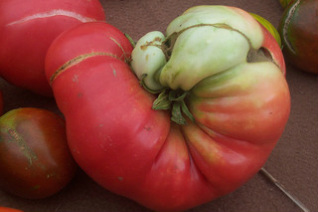
Have we reached the tipping point on food waste? There’s definitely more buzz lately. Last month the UN launched a global campaign to cut the “1.3 billion tonnes of food lost or wasted each year” around the globe.
In 2010, Jonathan Bloom, a U.S., author and activist — tireless champion of waste reduction—released his book American Wasteland: How America Throws Away Nearly Half of Its Food (and What We Can Do About It). Imperfect looking (but perfectly edible) produce, like the tomato above, is one of the foods he says most people would toss.
At our house, we got fed up with food waste several years ago after an embarrassing clear out of our freezer. As my husband and I pulled out package after package of food—snowy, unappetizing victims of freezer burn, quite literally gone to waste—I resolved it wouldn't happen again.
It's been a fascinating journey—but way more uncomfortable than I expected. The reasons we waste food aren’t very flattering. Sometimes we’re as finicky as our kids. (Funny looking tomato? I don’t want to eat that.) Or we’re conspicuous consumers. We buy glorious cartfuls of (local, organic) food at all the right shops and markets but waste half of it because, let's get real, we hit the drive-thru three times a week. Or we’re just plain greedy. We want choice, four kinds of bread in the bread basket, even if we've cut back on gluten and only make sandwiches twice a week. (Guilty.)
But other factors are at work too: our hectic lifestyles, and a consumer culture pressuring us to buy, buy, buy. Anyway, whatever's to blame, we all know where it leads—to nasty stuff growing at the back of our fridges, freezers and pantries. The huge takeaway though is that wasting food has big-time environmental, financial and social consequences. As Bloom writes: “Wasting food squanders the oil and water used to produce it, and food rotting in landfills creates climate-changing greenhouse gas emissions.” This is also food that hungry people could have eaten.
The upside? I’ve found turning things around isn’t actually that hard—a little planning here, a little family communication there—and you can save quite a bit of coin too. According to one estimate, the average family of four wastes more than $2,000 worth of food every year. How would you like to spend those savings?
Does food get wasted at your house? Have you found ways to waste less? I’d love to hear about it.

 RSS Feed
RSS Feed
